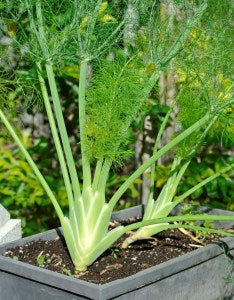
How I Grow Fennel Here in Metro Manila
Share
I really didn’t know that much about fennels until I started growing them from seeds about 6 months ago. I now have several fully grown fennel plants in my herb garden which are all ready for harvest whenever I need them. With their feathery leaves, they actually add a lot of charm to my container herb garden. Knowing that fennels are not a native in my home country, I’m quite amused that these herbs are thriving quite well here in Manila’s warm summer weather.
I have always thought before that all fennels grow a bulb, like what I would usually see in most grocery stores. As I found out later, not all varieties of fennel will eventually form a bulb. In addition, even if you do grow the fennel bulb variety, you will not likely see your fennel plant form any bulb if the weather gets too warm (like what we have now). Nevertheless, you can still find this herb useful for your culinary needs because the leaves, stalk and even flowers of the fennel are all edible and aromatic. Similar to dill, fennel has a nice mild anise aroma that goes well with many seafood dishes. Simply sprinkle chopped leaves, stalk or bulb over your cooked dish or favorite Italian salad dressing.
How to propagate
The easiest way to propagate the fennel is through seeds. Soak the seeds overnight before sowing. Sprinkle a few seeds over a moist soil bed or seed tray, and then cover with a thin layer of compost. Spray water daily to moisten the top soil. The seeds will germinate in about 5 -8 days. Keep the seedlings away from direct sunlight for another week, or until their stalks and leaves become sturdier.
Gradually expose the seedlings to the sun for at least two hours every morning for the next 3 weeks. After 4 weeks, thin out or transfer the seedlings to any medium sized container or directly on the ground. Make sure to transfer the seedlings during the afternoon, and once transferred, do not expose to direct sunlight for 24 hours.

Ideally, fennel needs 4 hours of sun, preferably in the morning. Beware that too much exposure to the sun’s heat could scorch its leaves or induce bolting (producing flowers), thus diminishing that fennel aroma. Once it bolts, the plant slowly withers and die, and this is irreversible. To prevent bolting, provide some dappled shade, especially at noon and early in the afternoon. Keep the soil continuously moist and consider mulching to prevent moisture from evaporating too quickly.
Not all fennel varieties produce the bulb. The bulb is actually the swollen stem at the base of the plant, unlike the root bulbs that you see in onions, garlic or potatoes. Take note however that the fennel bulb may not form properly if the weather is extremely hot.
Pests are not really a major issue for fennels. In fact, it can even repel some common pests or insects. Use compost to fertilize the soil after about a month after transplanting them.
When to harvest

The fennel leaves, bulb and stalks are all useful in cooking. Harvest fennel leaves by cutting the stem from about 2 inches above the base. Generally, fennel leaves can be harvested in as early as 3 months from sowing. If you are growing it for the bulb, you have to wait for the bulb to form. You can harvest the bulb when it is about 2 inches in size, by cutting the entire plant at the base. A word of caution though, it may take a little while before my fennel bulb develops into its ideal size due to the hot weather in Manila.
Happy gardening!
